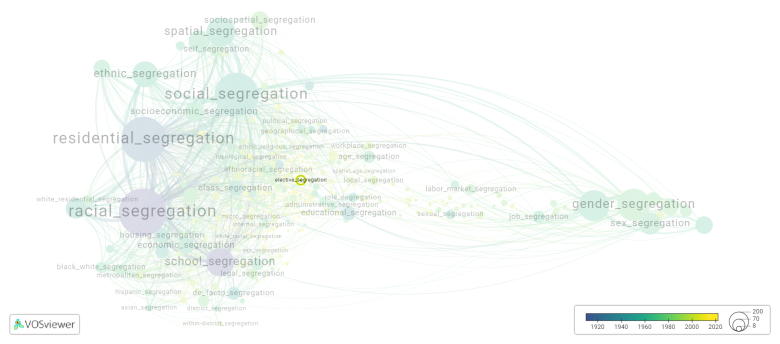Elective segregation: Difference between revisions
(Creating page) |
(Creating page) |
||
| (9 intermediate revisions by the same user not shown) | |||
| Line 1: | Line 1: | ||
===== Date and country of first publication<ref>Date and country of first publication as informed by the Scopus database (December 2023).</ref>===== | |||
2013<br> | 2013<br> | ||
Italy | |||
===== Definition ===== | |||
Elective segregation refers to the intentional separation of individuals or groups based on certain characteristics or preferences. Unlike mandatory segregation, elective segregation is a voluntary choice made by individuals or groups to separate themselves from others who are different from them. This separation can be based on various factors such as race, ethnicity, religion, socioeconomic status, or personal preferences. | Elective segregation refers to the intentional separation of individuals or groups based on certain characteristics or preferences. Unlike mandatory segregation, elective segregation is a voluntary choice made by individuals or groups to separate themselves from others who are different from them. This separation can be based on various factors such as race, ethnicity, religion, socioeconomic status, or personal preferences. | ||
| Line 12: | Line 14: | ||
It is important to note that elective segregation is different from forced or institutionalized segregation, which is mandated by laws or policies. Mandatory segregation, such as historical racial segregation in the United States, was legally enforced and resulted in systemic discrimination and inequality. | It is important to note that elective segregation is different from forced or institutionalized segregation, which is mandated by laws or policies. Mandatory segregation, such as historical racial segregation in the United States, was legally enforced and resulted in systemic discrimination and inequality. | ||
==See also== | ==See also== | ||
== | ==Related segregation forms== | ||
Elective segregation is frequently discussed in the literature with the following segregation forms: | |||
[[social segregation]] | |||
[[File:elective_segregation.png|780x780px]] | |||
This visualization is based on the study [[Segregation_Wiki:About| The Multidisciplinary Landscape of Segregation Research]]. | |||
For the complete network of interrelated segregation forms, please refer to: | |||
* [https://tinyurl.com/2235lkhw First year of publication] | |||
* [https://tinyurl.com/2d8wg5n3 Louvain clusters] | |||
* [https://tinyurl.com/223udk5r Betweenness centrality] | |||
* [https://tinyurl.com/244d8unz Disciplines in which segregation forms first emerged (Scopus database).] | |||
==References== | |||
==Notes== | |||
<references /> | |||
{{NoteAI}} | |||
==Elective segregation appears in the following literature== | |||
Fuentes F.J.M. | Fuentes F.J.M., Andreotti A., Le Galès P. (2013). Controlling the Urban Fabric: The Complex Game of Distance and Proximity in European Upper Middle Class Residential Strategies. ''International Journal of Urban and Regional Research'', ''37''(2), 576-597. https://doi.org/10.1111/j.1468-2427.2012.01177.x | ||
Done E.J., Andrews M.J. (202). How inclusion became exclusion: policy, teachers and inclusive education. ''Journal of Education Policy'', ''35''(4), 447-464. Routledge.https://doi.org/10.1080/02680939.2018.1552763 | |||
Latest revision as of 07:17, 16 October 2024
Date and country of first publication[1][edit | edit source]
2013
Italy
Definition[edit | edit source]
Elective segregation refers to the intentional separation of individuals or groups based on certain characteristics or preferences. Unlike mandatory segregation, elective segregation is a voluntary choice made by individuals or groups to separate themselves from others who are different from them. This separation can be based on various factors such as race, ethnicity, religion, socioeconomic status, or personal preferences.
In some cases, people may choose elective segregation to be among others who share similar backgrounds, beliefs, or lifestyles. This can be seen in communities or neighborhoods where individuals voluntarily choose to live among others who belong to the same racial or ethnic group, or who share similar religious beliefs.
Elective segregation can also occur in education, where individuals or parents may choose to enroll in schools or programs that align with their preferences. For example, some parents may choose to send their children to private schools with a specific religious affiliation or to schools that offer specialized academic programs.
While elective segregation is a personal choice, it can have social and cultural implications. It can contribute to the creation of homogeneous communities or groups, thereby limiting opportunities for diverse interactions and experiences. This can reinforce stereotypes, prejudice, and discrimination among different groups.
It is important to note that elective segregation is different from forced or institutionalized segregation, which is mandated by laws or policies. Mandatory segregation, such as historical racial segregation in the United States, was legally enforced and resulted in systemic discrimination and inequality.
See also[edit | edit source]
Related segregation forms[edit | edit source]
Elective segregation is frequently discussed in the literature with the following segregation forms:
This visualization is based on the study The Multidisciplinary Landscape of Segregation Research.
For the complete network of interrelated segregation forms, please refer to:
References[edit | edit source]
Notes[edit | edit source]
- ↑ Date and country of first publication as informed by the Scopus database (December 2023).
At its current state, this definition has been generated by a Large Language Model (LLM) so far without review by an independent researcher or a member of the curating team of segregation experts that keep the Segregation Wiki online. While we strive for accuracy, we cannot guarantee its reliability, completeness and timeliness. Please use this content with caution and verify information as needed. Also, feel free to improve on the definition as you see fit, including the use of references and other informational resources. We value your input in enhancing the quality and accuracy of the definitions of segregation forms collectively offered in the Segregation Wiki ©.
Elective segregation appears in the following literature[edit | edit source]
Fuentes F.J.M., Andreotti A., Le Galès P. (2013). Controlling the Urban Fabric: The Complex Game of Distance and Proximity in European Upper Middle Class Residential Strategies. International Journal of Urban and Regional Research, 37(2), 576-597. https://doi.org/10.1111/j.1468-2427.2012.01177.x
Done E.J., Andrews M.J. (202). How inclusion became exclusion: policy, teachers and inclusive education. Journal of Education Policy, 35(4), 447-464. Routledge.https://doi.org/10.1080/02680939.2018.1552763

